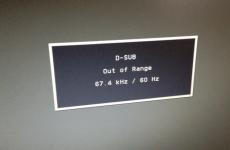Instructions for transferring programs from the internal memory of an Android device to a removable memory card. How to transfer apps from internal memory to SD card in Android Using third-party programs
Probably, each of us has encountered the problem of insufficient memory or simply wanted to transfer applications to a flash drive, since the memory was already full, and games and applications cannot be transferred to MicroSD and the notification “Insufficient memory on the device, some functions may be limited” was annoying.
Even if I deleted many applications and games, there was still not enough memory. But how to increase memory without losing everything? Later in this article we will look at and find out how to solve this problem.
I want to warn you right away that neither I nor the site administration are responsible for your actions. You do everything at your own peril and risk.
P.S. The article uses the most simplified words for better understanding.
To continue you will need:
- MicroSD Card with at least class 6 (preferably class 10) and larger than 4 GB in size
- (To create a second partition)
- (For transferring applications and games)
- (For transferring games with cache)
To increase memory, we will have to transfer your applications to the so-called second partition of the MicroSD card (for transfer you need ), and we will create it ourselves. If you already have a second section on your card, you can skip this item.
Creating a second MicroSD partition
1. Save all files on another medium (For example, on a computer)2. Disable MicroSD card along the path “Settings/Memory/Disconnect memory card”

3. If you have ROOT rights, install, if not -

4. After starting, click on “+” twice  5. Select “Ext4” in Part 2. If you have a device running Android 2.2-2.3, select “Ext 3”
5. Select “Ext4” in Part 2. If you have a device running Android 2.2-2.3, select “Ext 3” 
 6. In Part 2, select the size, how much memory you want to allocate in MB from the card for applications and games (The more the better)
6. In Part 2, select the size, how much memory you want to allocate in MB from the card for applications and games (The more the better)  7. Look at the first graph with a white bar, with the amount of memory remaining and enter these numbers in Part 1
7. Look at the first graph with a white bar, with the amount of memory remaining and enter these numbers in Part 1 
 8. Check if you did everything correctly. If everything is correct, click on the menu button or the so-called “three dots in the corner”, and click on “Apply changes”
8. Check if you did everything correctly. If everything is correct, click on the menu button or the so-called “three dots in the corner”, and click on “Apply changes”  The hardest part is over, you can reconnect the memory card (Settings/Memory/Connect memory card), transfer files back to the flash drive, but before that you can notice that the size of the memory card has decreased. This is how it should be, because we created the second section.
The hardest part is over, you can reconnect the memory card (Settings/Memory/Connect memory card), transfer files back to the flash drive, but before that you can notice that the size of the memory card has decreased. This is how it should be, because we created the second section.
Setting up transfer to the second partition
We need to install the program (Google Play)
After installation, open the application. You should see a window like this. Select "Ext 4" or "Ext 3" for Android 2.2-2.3 and click on "OK".



After rebooting, open the application. You should see a list of applications.

Now we will look at what can be transferred and what is better not to transfer.
Let's just say that system applications should never be transferred. You never know what will happen. Therefore it is better to endure custom applications(The ones you installed yourself). I do not recommend transferring those applications that you actively use (For example, Browser or WhatsApp and the like).
And to make it more convenient, the application has sorting. To do this, click on “Exact three stripes” and select “Custom”.


A list of your applications should appear in front of you. Now you can select the applications that you want to move to the second partition and link them there. Click on “Three Dots”, then on “Several”, select the applications to transfer and click on “Send”.



A few minutes of waiting and you're done! You more memory, and you can also download games and applications and transfer them. If you delve into the Link2SD settings, you can enable auto-link. This is a function that automatically transfers the application to the second section of the card, thereby making your life easier.

You can also change themes in the settings, buy the Pro version, and so on. But that’s not about that now. In general, we figured out the main problem. But, I want to tell you, Link2SD does not transfer game cache (Game cache is files in .obb format along the path Android/obb/“game package name”). So what should we do? Let's talk further.
Transferring game cache and data to a MicroSD card
Game caches can be transferred using a great program called . I’ll say right away that the cache is transferred to the flash drive itself, and not to the second partition.
Open the application, and swipe from the left edge of the screen to the right edge (Swipe) and tap on “Application Analyzer”


Many owners of Android devices sooner or later, especially if the user is not sophisticated in knowledge computer technology, are faced with a similar situation. By manually or automatically installing applications on the gadget's internal memory, we gradually reduce its volume. Over time, the device begins to work slower and slower. Those programs that used to start in a matter of moments now start slowly. And then it’s generally impossible to send SMS or listen to the song normally. In addition, I get a message that there is not enough space in the memory of the Android device. So we've arrived. It's time to start optimizing internal memory apparatus. There is no other way. The main way to solve this problem is android installation applications to the memory card. But first you need to understand what types of memory your device has.
Types of Android memory
RAM is memory that is used by various processes and applications while the device is running. When the power is turned off, all data contained in it is erased. The larger its volume, the more application instances can be launched at the same time. That is, the more operational, the more you can afford right away. For example, listen to music and surf the Internet through a browser.
At this stage, volume is considered the gold standard random access memory in 1 GB. IN budget models this figure averages 512 MB. To some extent, a large amount of RAM allows you to go longer without transferring android applications to a memory card. Moreover, starting from version 2.2 of this operating system, it has built-in support for selective launch of processes. Now the device itself knows which application data to leave active. In earlier versions, when the entire amount of RAM was filled, the user received a message about its fullness and the impossibility of launching the application.
ROM is the internal memory of the device, onto which the data of the operating system itself is written during firmware. Unlike operational data, this data is saved after recording without changes, even after the device is turned off or rebooted. They are not modifiable and you will not be able to move applications to your Android memory card.
Internal memory of the device - recorded here user information and data installed programs. All information is available for change. How much is left free space in the internal memory is displayed in the settings. If the entire volume is almost full, then you can move applications to the android memory card.
Memory cards
An expansion card, or flash drive, is used to increase the amount of internal memory. Happens various types and sizes depending on the supported slot. All information recorded on it is available for modification and is saved when the power is turned off. You can also find out about the degree of filling in the “settings” section of the gadget menu. The main purpose of expansion cards is to free up resources of the device's internal memory.
The essence of the problem
After purchasing a new device, the owner, who understands the controls, begins to customize the gadget “for himself.” Personalize by installing new applications and gradually filling the internal memory. After all, in addition to filling up the RAM with a lot of running processes, and the internal volume is also filled to capacity. In this case, the system issues messages about this. Removal unnecessary programs and data solves the problem for a short time due to the constant influx of information and automatic installation updates. Optimizing the system and deleting temporary files is also a temporary solution to the problem. There is nothing else left to do but transfer applications to the android memory card.
Let's start solving the problem
An inexperienced user would do this by first copying all the data to the computer and then moving it to a flash drive. Another solution could be online data storage. To do this, you need to download all the necessary “extra” information from your phone to the server of some specialized Internet resource for further storage and use at the right time. This is where the problem of accessing this data via the Internet arises. Unlike foreign countries, access to the network via wi-fi is still too poorly developed. And downloading through Edge will not only take a long time, but also be expensive.
Everything is much simpler. Transferring data to an expansion card is possible through the built-in operating system tools using a file manager. You just need to mark those that should be transferred. What if you need to move Android applications to the memory card? For this purpose, in this operating system, starting from version 2.2, this feature is implemented at the software level.
Open the gadget menu. Go to the “Settings” item. Next, go to the “Applications” sub-item and from there to “Application Management”. A list of installed programs opens in front of you. By clicking on the name of the desired application, we will see all the information about it. On the right there is a button that says "move to SD". If it is active (displayed in white), then this application can be transferred to the Android sd from the internal memory of the device.
Programs for transferring applications
Certainly, a new version operating system is good. But what should those whose devices run on versions lower than 2.2 and their system do not know how to install Android applications on a flash drive?
The first option that immediately comes to mind is flashing the gadget. But this matter is so troublesome and time-consuming that first it is better to look for other ways to solve the problem.
Omniscient programmers have already thought for us and written a series of special programs For android port applications on sd.
App 2 SD program.
It contains all the necessary tools for transferring applications not only from external memory to an expansion card, but also vice versa. Having launched the program, a table with icons of available functions appears in front of us. At the top there are three keys for selecting the desired operation option: with roaming applications located on the memory card and located in the internal memory of the device. Before transferring applications to the memory card on Android, click on the icon of the program being moved. All information about it is displayed before us and possible options actions: transfer, erase data.
Using the menu that appears after pressing function keys device, you can transfer all installed programs, update the list, configure, clear the cache, or update App version 2 SD to professional. Moreover, the price of the transition to pro versions is only 2$.
Program Move2SDEnablerv0. 96.
It will be useful not only for those whose gadget runs on Android below version 2. 2. In devices with more later version operating system Move2SD Enabler v0. 96 allows you to move to a flash drive even those applications that are marked as “unportable” in the standard file manager (the transfer button is inactive). Before saving applications to your Android memory card, familiarize yourself with the space occupied by this program.
Link2SD program.
Unlike others, it allows you to export applications not only completely, but also in parts. That is, you can move individual libraries. Another advantage of Link2SD is that it is installed immediately in one package without copying files or running scripts.
After transferring the application with this program in devices running versions of the operating system up to 2.2, it begins to be displayed only after the device is rebooted.
To export, 2 partitions must be created on the expansion card. One at the base file system FAT 32, and the other ext2 (the limitation is not relevant for new versions).
Of course, these programs completely solve the problem. But in Android, how to install applications on a flash drive right away?
Install immediately
Of course, the memory of devices, especially phones, is not infinite. And constantly transfer programs using specialized applications or built-in file manager Android is tedious.
And I would like to know how to install applications on a memory card on Android.
Unfortunately, by default, all applications are installed in any version of Android on the internal memory. The solution to this problem can be considered to be flashing the gadget with a third-party version of the OS. But this is a very troublesome matter. In addition, you need to have decent skills and knowledge in handling this kind of software.
After installing the application, if possible, immediately move it to the memory card. Compliance with this simple rule will help you save built-in memory resources.
Install one of the cleaning utilities on your gadget. For example, Android Assistant. After a while, systematically launch it, and clean the system and clear the cache. Using this program allows you to clear the internal memory of temporary and unnecessary files(“system garbage”), and thus save space.

Comfortable work
Make it a rule to uninstall applications as soon as they are no longer needed.
When downloading via a browser on the Internet, different multimedia information immediately set the save path to the folder on the expansion card.
By following these tips, you can ensure comfortable work on your device, even if its internal memory resources are small. And the developers will definitely answer us about how to ensure that applications are installed on the Android memory card with the release of one of the next versions of this wonderful operating system.
Instructions for transferring programs from internal Android memory devices onto a removable memory card.
Typically, the memory card in a tablet or phone has one partition with the FAT or FAT32 file system. In order to be able to move and then run a program from a memory card, the card must contain two sections. One of them will be used as usual for storing data, and the other will be used for programs moved to the card.
Important! It is the second partition that will be used to move programs to it. This must be taken into account for further work.
IN Android version 2.2 and higher, the ability to transfer applications to a memory card is already available in the system, but for those who have a tablet or phone with more early versionAndroid, and there is no opportunity or desire to update the firmware, there is nothing left to do but use third-party applications.
So, to transfer programs already installed on the internal memory to a memory card, we need two programs. A program for creating and deleting file system partitions, and a program for transferring programs to a memory card.
Preparing the map
Let's start with the first program. There are many programs that allow
manage partitions on physical storage media, but we will probably focus on the simplest and most convenient of them. This program .
You can download it from the following link: download
The program works with operating systems Windows 2000/XP/Vista, and Windows 7.
To work, we need two things - the program itself and a card reader.
Let's get started with the program MiniTool Partition Wizard Home Edition .
Attention! Before working with the program MiniTool Partition Wizard Home Edition, save everything that is recorded on the memory card, since all data on the card will be destroyed.
1. Download and install the program. We remove the memory card from the device and insert it into the card reader. Windows will determine new disk and will display it as " removable drive" 2. Delete partitions on the memory card. To do this, we launch the program. At the bottom of the program window, all drives that are currently connected to the computer will be displayed. This and HDD, And USB flash drive, if it is connected, and our SD card.
The picture shows an example. We see two hard drives, 465 and 74 gigabytes in size, and a 3.8 gigabyte SD card with two partitions on it:
Right-click on each section and select the option “ delete" - delete the section.
Before this step, you should make sure that you are selecting partitions on the memory card, and not on the hard drive or other drive!
1. Create a section for your data. To do this, right-click on the free space of the memory card and select the option “ create».

2. In the window that opens, in the drop-down menu “ Create As:» select « Primary", and in the menu " File System:» select the file system type FAT, if the partition is less than 2 gigabytes in size. If you want to create a partition larger than 2 gigabytes, select the file system type FAT32. Use the slider to set the partition size and click “ OK».
3. Create a section for programs that we will transfer to the memory card. To do this, again right-click on the free space of the memory card and select the option “ create" In the drop-down menu " Create As:» select « Primary", and in the menu " File System:» choose FAT32 as a file system. Using the slider again, set the partition size and click “ OK».
4. We apply all the changes we made. To do this, click on the left top corner program window button " Apply" After this, the program will create and format the partitions.
Important! Program MiniTool Partition Wizard Home Edition does not make any changes to the memory card until you press " Apply" Until this point, you can cancel operations using the " Undo", or completely discard all changes by clicking " Discard »
Now that the card is prepared, you can install it in your tablet or phone and begin the process of transferring programs to it.
Transfer of programs.
To do this, we need to download and install the program on your tablet or phone Link2SD.
Link to download the program: Link2SD market.android.com
Attention! To work with the program you will need Root rights. How to get a license Root on your tablet, described in the corresponding thread of our forum.
When you turn on your phone or tablet, the program mounts a second partition on the memory card and makes it available to the operating system.
Working with the program is very simple. After the first launch of the program, a window for selecting the type of file system on the second partition of the memory card will appear. Select the type of partition that you created in the first part of our instructions. Then a window will appear asking you to provide Root program rights, and they should be granted to her. After which the program will create a mount point for the second partition of the card in the system and ask you to restart your phone or tablet.
After rebooting the tablet, you can begin transferring applications from the internal memory to the card.
1. Launch the program Link2SD. A list of installed applications will appear on the tablet screen.

2. Select the program that needs to be transferred to the card. In the window that opens, click “ Create Link»
3. The following window will open. If we want to transfer temporary files (cache) to the card, check the box next to “ Link davlik-cache file too" and click " OK»

4. The program will “think” for a while, and if the application is successfully transferred, it will display the message “ application linked to SD card.»

5. Click " OK", we leave from Link2SD, and now we can run the moved program.
Applications that have already been moved to the memory card in the Link2SD program list contain a corresponding mark.

Questions and answers:
-Can all programs be transferred to a memory card?
No, some programs can only work correctly when installed in the internal memory of the device.
-Can I cancel the transfer of the program and return it to the internal memory of the device?
Yes, just select it in the list and click " Remove Link»
-What happens if I update a program that has been moved to the card?
When updating a moved program, the application file itself and data files will first be saved in the internal memory of the device, and then the program Link2SD will automatically transfer them to the memory card in background. No need to manually move the updated application.
-How much space does the program take up in the device’s RAM during everyday use?
The program only starts the process of mounting partitions on the memory card, and is not itself located in the device’s memory during normal use.
Some comments.
Program Link2SD itself detects applications that were moved using the operating system itself Android systems(in versions Android 2.2 and higher)
System applications cannot be transferred to a memory card. Program Link2SD will not give you this opportunity.
When you connect your device to your computer, the OS Android unmounts the first one FAT file system section of the memory card. However, the second partition will remain mounted and you can run programs from it.
Program Link2SD does not move the program folder itself from the internal memory; only the program and cache files themselves are transferred.
Normal 0 false false false RU X-NONE X-NONE MicrosoftInternetExplorer4 MiniTool Partition Wizard Home Edition






